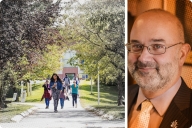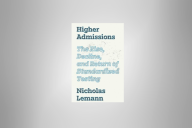You have /5 articles left.
Sign up for a free account or log in.

Researchers aim to pinpoint where rural colleges are located.
James Brey/Getty Images
What is a rural college? And where can such institutions be found? The questions seem simple, but in higher education, the answers are surprisingly complex. Now two new reports aim to clarify them.
The first, released in December, comes from the University of Wisconsin and is titled “Mapping Rural Colleges and Their Communities.” Nicholas Hillman, an education professor at the University of Wisconsin who spearheaded the report, says the research was born out of the question “Where are rural colleges located?”
Hillman and his team combed through the Integrated Postsecondary Education Data System as well as the Database of Accredited Postsecondary Institutions and Programs to understand where colleges are located, then plugged their addresses into a data set and mapped those colleges. They turned up programs in far-flung corners of the U.S. as well as educational partnerships serving students in unexpected locations, such as hotels and conference centers.
“There are places where education is happening all around the country that we would not know about if we simply relied on IPEDS,” the massive trove of Education Department data, Hillman explained. That’s why they paired it with DAPIP, which contains details on accredited postsecondary institutions and programs.
The second study, released Monday, comes from the Alliance for Research on Regional Colleges and is also a mapping project. However, the ARRC effort focuses on identifying and mapping institutions that are rural-serving rather than colleges that are located in rural areas, factoring in colleges that may be in well-populated towns or suburban areas but have a strong regional pull.
“Serving goes beyond just where you’re located,” said Andrew Koricich, an education professor at Appalachian State University and executive director of ARRC. “The way we approached this was not a strict definition where you must meet this criteria and that criteria, but instead, to come up with this metric that is relative so that we’re comparing institutions to each other.”
Both studies received funding from Ascendium Education Group. Though it might seem like the mapping projects would overlap, researchers say they are complementary, like salt and pepper.
Rural Colleges by Location
Hillman and his team crunched county-level data to create clusters of commuting zones. Instead of 3,142 U.S. counties, there are 625 commuting zones, which the report notes “can be a useful measure of local labor markets. They can also serve as a useful geographic measure for determining which colleges are nearby or at least within typical commuting distance.”
“The idea that people go to college nearby where they live is captured by this concept of a commuting zone,” Hillman explained.
Hillman’s team identified and mapped colleges in rural areas, including additional educational programs that give a sense of how and where higher education is delivered. For example, users can look up rural community colleges, four-year universities and trade schools, or they can locate programs offered in prisons, on military bases, at community agencies, in hotels and so on.
“It’s training and programs for many different locations happening in these places that are actually exciting to think about,” Hillman said. “Programs meeting students where they are.”
Another finding that emerged from the data is that enrollment at institutions located in rural areas is down, a trend that varies by sector. Notably, rural community colleges are seeing some growth, though this growth comes not in the public sector but at private nonprofit and for-profit colleges. While rural community colleges saw an overall enrollment increase of 4.8 percent between fall 2019 and fall 2020, Hillman’s research shows, enrollment at public community colleges fell 9.9 percent, private nonprofits had a 1.4 percent increase and for-profits saw a 22.8 percent spike.
Rural colleges that offer bachelor’s and master’s degrees saw a 3.9 percent decline and doctoral institutions were down by 2.6 percent over all. Broken down by sector, public rural colleges that offer bachelor’s and master’s degrees experienced a 3.7 percent enrollment decline, compared to a 3 percent drop for their private nonprofit peers and a 4.9 percent dip for comparative for-profit institutions. Enrollment at rural public doctoral institutions was down by 3.3 percent—compared to 1.8 percent for private nonprofits—while for-profits saw no change, per Hillman’s analysis.
“Even in rural places, I think there’s some divergence happening,” Hillman said.
Identifying Rural-Serving Colleges
A year in the making, the ARRC report mapped out 1,087 rural-serving institutions. Identifying such colleges, researchers said, will provide a better understanding of higher education in rural areas. Among the factors ARRC considered are what percentage of a college’s home county population is considered rural, adjacency to metro areas and the percentage of degrees conferred in agriculture, natural resources and parks and recreation—degrees that are important to rural areas.
“If we don’t have a way of identifying [rural-serving institutions] in an inclusive way, we’re never going to figure out how to do better, we’re never going to be able to tell the degree to which they may or may not be underfunded, we may not be able to tell the degree to which certain state-level policies disproportionately impact these institutions,” Koricich said.
The ARRC mapping project also breaks down the rural constituencies these colleges serve and dispels certain myths about those populations, Koricich said. For example, roughly one-third of historically Black colleges and universities are rural-serving institutions, as are 18 percent of high-Hispanic-enrolling institutions, 93 percent of tribal colleges and 94 percent of high-Native-enrolling institutions that are not tribal colleges.
“Rural is not a proxy for white; there is a lot of diversity in rural areas,” Koricich said.
He adds that rural-serving institutions are often in regions facing socioeconomic distress—places with high poverty, low employment and population loss as Americans migrate out of rural areas.
“I think it really emphasizes that these institutions are important engines for economic opportunity, for educational access and also for lifting diverse populations out of poverty,” Koricich said.
Challenges for Rural Colleges
As executive director of the Michigan Center for Student Success at the Michigan Community College Association, Erica Orians works with 28 public community colleges across the state.
“Despite the fact that they may be small institutions, or serve a smaller number of students, that doesn’t necessarily diminish their importance in their local communities,” Orians said. “Community colleges are typically very focused on preparing the future workforce and economic development issues in their local area, in addition to the role that they play in getting students on the right path to transfer to a bachelor’s degree–granting institution. But enrollment declines really force institutions to think about what their role is in local economic development.”
Beyond enrollment, a 2021 report from the Association of Community College Trustees found other challenges extending to funding disparities at the local, state and federal level; limited access to high-speed internet; and limited resources for basic student needs and mental health.
Those challenges extend to colleges in rural areas as well, experts say. Now researchers hope these new reports can find their way to lawmakers to serve as a resource on rural colleges and help inform public policy.
“This report helps show that the local [education] marketplace varies widely, depending on where you live,” Hillman said. “I hope that’s something that this report can help researchers focus on even more—that these local contexts vary considerably across the country.”
ARRC hopes its new mapping tool is used by philanthropic organizations, researchers, journalists and politicians to help guide funding, policy making and reporting on rural issues.
“There are so many potential applications for this work,” Alisa Fryar, a political science professor at the University of Oklahoma and ARRC researcher, said by email. “For the philanthropic community, we hope this work will better support their efforts to identify institutions for targeted investment. For the research community, we hope the data work and related discussions will accelerate the next stage of their research on rural higher education. For policymakers, this work can used to better understand the landscape of rural higher education more broadly and bring attention to the diversity within rural higher education. But most of all, we hope it will support more conversations, more research, and more critical thinking about rural higher education.”








